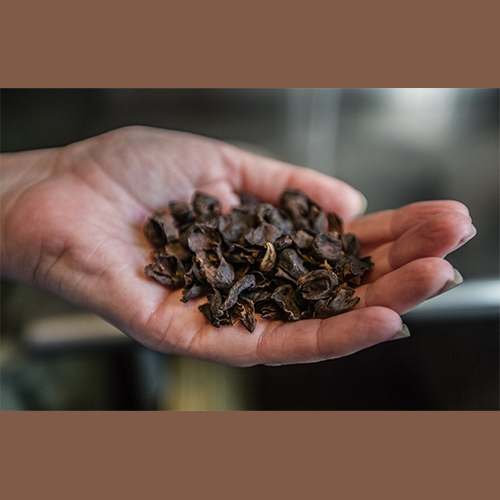When you enjoy your Sasquatch Coffee every morning, it is hard to imagine the process those delicious coffee beans went through to land in your kitchen. Making the process of harvesting the coffee we love so much is an important one, and, luckily, a group of innovators in Seattle, WA are working towards making growing and harvesting coffee more sustainable for the countries that cultivate coffee beans. Their solution is simple, Coffee Flour. Made with the left over pulp from discarded fruit from coffee plants, Coffee Flour is rich in antioxidants, iron, and fiber. Read more about this important work here:
You know what you want in your coffee, but what do you want your coffee in? For cutting-edge chef Jason Wilson, the answer — in a particular form — includes supple pastas and a syrupy balsamic dressing, charred eggplant dip and a crisp beer batter.
As executive chef of Seattle-based company Coffee Flour, the restaurateur is working with a product that recaptures the pulp that’s often wasted when coffee beans are harvested. At first, he said, it was “all about having this ingredient no one else had,” baking the byproduct into richly tinted, nutty-flavored waffles at his Miller’s Guild restaurant downtown. He tested it out in gnocchi and caramel sauce and other creations.
Eventually, Wilson said, it “became a wake-up call.”
He’s now executive chef at the Coffee Flour lab, located in his former Crush restaurant. At the six-burner stove that once produced gourmet tasting menus, he and his colleagues are constantly testing out new formulations for how the flour could be used, even to the point of producing an astringent, lemony tea. (Tea made from coffee, yes.)
What drew him in, Wilson said, was the idea of transforming an enormous waste byproduct into a global benefit
Along with the company founders, the James Beard Award-winning chef hopes the flour — technically a dried fruit powder — will become a game-changer for the economies of coffee-growing countries, for the environment, and even for public health. It’s the brainchild of engineer and founder Dan Belliveau, a former director of technical services at Starbucks and former project manager at Frito-Lay.
Belliveau was familiar with the pulp left over after coffee beans are harvested from the coffee cherry. While the pulp can be used for fertilizer, the company says that much is just left to rot. Dried instead and ground into an antioxidant-rich powder, it yields more iron per gram than fresh spinach and more fiber per gram than whole-wheat flour, by their calculations.
Yes, but … coffee? And flour? Like cooking with cocoa powder or whole grains, it turns out to have plenty of uses if the cook knows how to adjust recipes to its particular qualities. A percentage can be substituted for all-purpose flour to add nutrients, flavor and color (and some caffeine, which can be seen as a positive or a negative).
It was a timely recycling notion in an era when more people are paying attention to food waste, sounding alarms over scrapped supplies ranging from wilted vegetables forgotten in the crisper to squandered leftovers from a supersized restaurant buffet. About one in four calories intended for consumption worldwide are never eaten, according to a United Nations report, a particularly striking figure given the amount of accompanying global hunger. Recapturing calories that weren’t directly intended for consumption sounded like a striking plan.
Coffee Flour drew early investors, and found businesses interested in experimenting. The flour is a staple in foods at Google’s cafes and is baked into a best-selling bagel in the Japanese Bagel & Bagel chain. It was featured in a dinner series made entirely from waste products at acclaimed chef Dan Barber’s Blue Hill restaurant in New York, and the Seattle Chocolate Company recently released a bar using coffee flour in its jcoco line, advertising “smoky, citrus and roasted fruit” flavor notes. Marx Foods, which recently became the flour’s first retail outlet, reports that it’s selling unexpectedly fast, both online and in the company’s Lower Queen Anne storefront.
Coffee Flour produced about 4.5 million pounds of the flour last year, sourcing pulp from countries that include Nicaragua, Guatemala, Vietnam and Mexico. The heart of their current research, though, is having the flour added to a corporate giant’s product lines — think coffee-flour additions to name-brand cereals or cookies or packaged cake mixes. “The goal isn’t, ‘How do we sell 100 million pounds at $10/pound,’ which is a really nice business. It’s, ‘How do we sell a billion pounds at a dollar a pound?’ ” said Belliveau. “It’s the same financial goal, but the difference is, at $100 million that’s not going to have an impact on the environment.” The goal is for 30 percent of the flour to stay in its country of origin, Belliveau said.
For Wilson, the point where the flour became a cause rather than an ingredient came when visiting Nicaragua and seeing how coffee is harvested there. He saw workers making lunchtime tortillas on a drainage pipe cut into pieces and heated by a log fire. He began thinking, he said, about the nutritional benefits of adding coffee flour to the tortillas, and the economic benefits the workers could see from recapturing and profiting from it. The bags used for hauling coffee flour are about one-third the weight of coffee-bean bags, making the jobs more accessible to women. That bonus especially struck Wilson’s lab colleague Erin Brannan, who sees the job as something beyond the normal cooking pleasures of testing out a chewy coffee-flour pizza crust or curry-scented carrot cake.
“If I can do work like this that affects people’s greater being, I’m doing work that really matters to me,” Wilson agreed.
It’s still cutting edge — but in a different way.
SRC: Find the original article Seattle Times article here: www.seattletimes.com/life/food-drink/coffee-flour-how-innovators-turned-a-waste-product-into-a-superfood/
